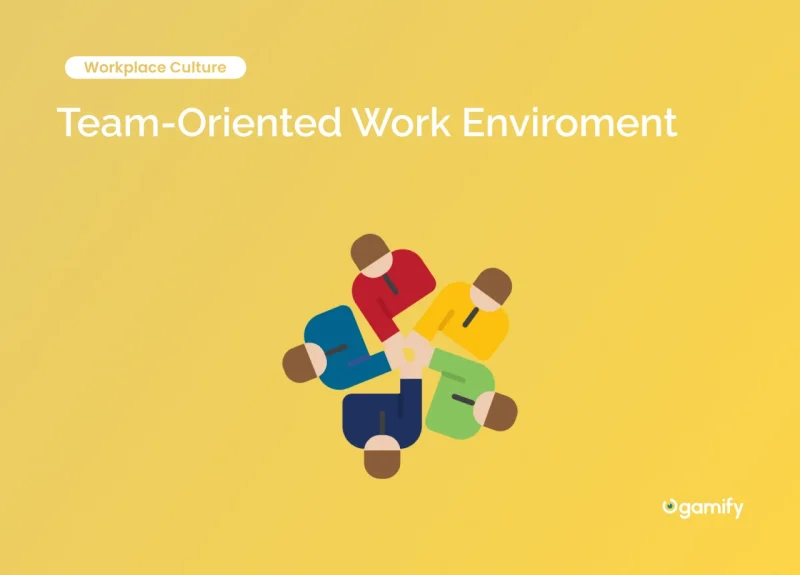A team-oriented work environment has emerged as a critical component of organizational success in today’s changing corporate climate. This strategy prioritises staff cooperation, highlighting the value of teamwork above individual job fulfilment. A clearly defined atmosphere focusing on the entire team allows for effective communication, aligning goals, and strengthening group cohesion. As a result, businesses that effectively foster this culture frequently gain a competitive edge in the market, higher levels of productivity, and higher levels of employee morale.
The idea of a team-oriented workplace is centred on encouraging a “we” over “me” mindset, highlighting the importance of cooperation, and developing close relationships among team members. By encouraging open communication, exchanging ideas, and contributing individual talents, this strategy eventually moves the company closer to its stated aims and objectives. A business may better use the potential of its staff and survive in a more competitive world by comprehending the relevance of team focused meaning workplace.
What Does Team Oriented Mean?

Team-oriented meaning that work environments emphasize the importance of collaboration and teamwork within an organization. Employees in a team-focused workplace are encouraged to work together to complete tasks and achieve shared goals. A key aspect of team-oriented leadership involves focusing on individual motivations and well-being and fostering a sense of unity among team members.
In a team-focused environment, leaders strive to create a workplace culture that values effective communication, shared goals, and a strong sense of community. These businesses prioritize the team’s needs over singular accomplishments, ensuring each member has the necessary support to succeed.
A crucial aspect in building a team-oriented workforce is understanding the different types of teammates that make up the organization. By identifying the strengths and weaknesses of each employee, leaders can create dynamic teams with individuals who complement each other’s skill sets. Focusing on communication skills is vital in maintaining effective collaboration within diverse groups.
Moreover, various types of team structures exist within an organization, each requiring unique strategies to inspire cooperation. From cross-functional teams to virtual teams, understanding the unique challenges faced by each group is essential to fostering team cooperation.
Ultimately, a team oriented environment thrives when leaders and employees prioritize unity, communication, and collective goal-setting. By adopting a team-focused approach, organizations can improve company culture and achieve more tremendous success.
What Contributes to Team Orientation?

A team-oriented work environment enhances collaboration, communication, and productivity among employees. Understanding the factors contributing to team orientation is essential for businesses aiming to create a healthy, cooperative atmosphere.
Trust among team members and management is a foundational element in a team-focused environment. When employees believe their managers are approachable, they feel more comfortable openly discussing their thoughts and concerns, inevitably leading to improved morale. Furthermore, strong communication serves as the backbone of team-oriented workplaces. Open dialogues pave the way for sharing valuable ideas, fostering cohesion, and ensuring that everyone’s input is valued.
Another critical aspect of team orientation is team-focused leadership. Managers must possess robust people management skills to facilitate a “we” over “me” mentality, emphasizing collaboration and shared goals. A team-focused leader can cultivate a workplace culture centred on collective success by providing timely feedback, acknowledging individual contributions, and rewarding teamwork.
To be teamwork-oriented, every team member should develop strong interpersonal skills. Active listening, empathy, and adaptability enable employees to effectively understand and address their colleagues’ needs. Encouraging cooperation in a group-oriented approach helps foster an inclusive atmosphere where diverse perspectives complement each other and drive innovation.
Lastly, incorporating regular team building activities strengthens interpersonal bonds and camaraderie among employees. These activities facilitate a better understanding and appreciation of individual strengths and weaknesses, reinforcing the idea of mutual support within the team.
10 Ways to Create a Team-Oriented Workplace Culture

- Foster a “We” Mentality: Encourage a team-oriented mindset where employees prioritize collaboration and communication over individual accomplishments. Emphasize the importance of cooperation and shared goals to create a sense of unity.
- Encourage Open Communication: Transparent and honest communication is vital for a group-oriented work environment. Encourage employees to share their ideas, opinions, and concerns without fear of judgment or retaliation.
- Set Clear Expectations and Goals: Clearly define project objectives and individual roles within the team. Align each team member’s responsibilities with the overall goal-oriented company vision.
- Invest in Team-Building Activities: Regular team-building exercises and activities can help foster camaraderie and improve team members’ communication skills. Offer a variety of team-building activities to cater to different interests and preferences.
- Establish Regular Team Meetings: Schedule consistent team meetings to provide opportunities for onboarding, catch-up, and brainstorming sessions. These gatherings ensure that everyone is on the same page and contribute to a more cohesive, team-focused work environment.
- Enable Trust-Building: Trust is the foundation of effective collaboration. To foster team cooperation, create an environment where employees feel comfortable voicing their ideas, professionally resolving conflicts, and relying on one another.
- Celebrate Team’s Success: Recognize and reward team accomplishments, not individual ones. By emphasizing group-oriented wins, you encourage team members to value collective efforts over personal gains.
- Deal with Conflicts Proactively: Address conflicts within the team promptly and professionally. Encourage open discussions to resolve issues and maintain a harmonious work atmosphere.
- Provide Opportunities for Skill Development: Enhance your team’s productivity by offering training and development opportunities. Skilled employees are more likely to contribute effectively to a team oriented environment.
- Implement Wrap-Up Meetings: At the end of each project, hold wrap-up meetings to review accomplishments, lessons learned, and areas for improvement. This practice will help to refine processes, enhance team goals performance, and foster continuous growth.
What Obstacles Can Be Encountered in a Team-Oriented Culture

Various challenges may arise in a team-oriented work environment, potentially hindering efficient collaboration and achieving project objectives. One prevalent issue is the lack of clear communication skills among team members. Effective communication is crucial for understanding tasks, roles, and responsibilities, as well as for sharing ideas in brainstorming meetings or catch-up meetings.
Another obstacle in team-oriented workplace culture is working with different types of teammates who might have contrasting work styles or personality traits. This diversity might cause task conflicts and impede team cooperation. Acknowledging these differences and adapting to various team dynamics when engaging in team-building activities is crucial.
In addition to these interpersonal challenges, goal-related difficulties can emerge when there is an imbalance between task-oriented and team-oriented aspects within the team structure. This may lead to discrepancies in priority-setting and confusion regarding project objectives. Team members should adopt a goal-oriented approach, focusing on delivering results while maintaining a team-oriented mindset that values collaboration and support.

Team building and onboarding meetings play a significant role in integrating new members into the existing team structure. Ensuring that these activities provide opportunities for connection and understanding among team members is vital for creating a conducive work environment. However, poorly planned or executed team development activities might fail to address the underlying issues within the team, leading to persistent conflicts and communication gaps.
It is also essential to recognize the types of team meetings that best suit the project’s requirements. In some cases, wrap-up meetings might serve as an efficient method for consolidating ideas, while other projects could benefit from more frequent catch-up meetings to keep team members informed on progress and updates. Establishing an appropriate meeting structure can mitigate potential misunderstandings and lack of information, fostering a more effective teamwork oriented culture.
Advantages of a Team-Oriented Environment

A team-oriented environment focuses on collaboration, open communication, and employee mutual support. The organisation reaps various benefits when colleagues work together in a teamwork-oriented atmosphere. These advantages include enhancing workplace motivation, increasing productivity, and fostering team cooperation.
In a teamwork oriented setting, conflicts are often resolved more efficiently. Open communication among team members allows them to address issues promptly and find amicable solutions, contributing to the overall health of the working dynamics. It is crucial to note that a goal-oriented approach within a team oriented environment helps align individual goals with those of the organization, ensuring everyone works towards a common objective.
Moreover, a team focused environment contributes to improved morale. Managers in such settings are usually more approachable, allowing employees to seek answers to problems and feel supported. This sense of belonging leads to higher workplace motivation and increased employee satisfaction.

Employees in team-oriented workplaces also experience increased engagement, knowing their thoughts and ideas are valued by higher management. This engagement helps employees feel more invested in organizational affairs, ultimately contributing to higher productivity.
Furthermore, the importance of team cooperation in a teamwork oriented environment cannot be overstated. Colleagues learn to depend on each other’s strengths and support one another’s weaknesses, fostering a more efficient and effective working relationship. This tight-knit collaboration encourages creative problem-solving and innovation, requiring team members to genuinely listen, understand, and appreciate diverse perspectives.
FAQ
What are the key components of a team-oriented work environment?
A team-oriented work environment is characterized by collaboration, open communication, and shared goals. Diversity awareness is essential as it brings different abilities, skills, and backgrounds that encourage flexibility and innovative thinking. Clear roles and responsibilities and empathetic management help create efficiency and support within the team.
How can a team-oriented culture benefit an organization?
A team-oriented culture fosters increased productivity, higher employee engagement, and improved decision-making. By promoting collaboration and shared responsibility, employees can more effectively overcome challenges. A team-oriented environment also enhances employee satisfaction, retention, and loyalty, leading to long-term organisational stability.
What are some examples of successful team-oriented companies?
Leading companies like Google, Apple, and Netflix are known for fostering team-oriented cultures. These companies promote cooperation, encourage employees to share ideas and support diverse teams with unique perspectives. These successful establishments have achieved significant growth, innovation, and competitive advantage by cultivating strong team-oriented values.
How can employees contribute to a team-oriented environment?
Employees can contribute to a team-oriented environment by actively participating in group discussions, openly sharing ideas, and providing constructive feedback. Additionally, they should cooperate with colleagues, demonstrate adaptability to team dynamics, and adopt a positive, solution-focused mindset when faced with obstacles.
What strategies can team leaders implement to foster a team-oriented culture?
Leaders should establish a clear vision, define team goals, and regularly communicate this vision to team members. They can also promote inclusivity, recognize individual and team contributions, and provide growth opportunities for employees. Supporting open communication and encouraging collaboration demonstrates a genuine commitment to fostering a team-oriented culture.


